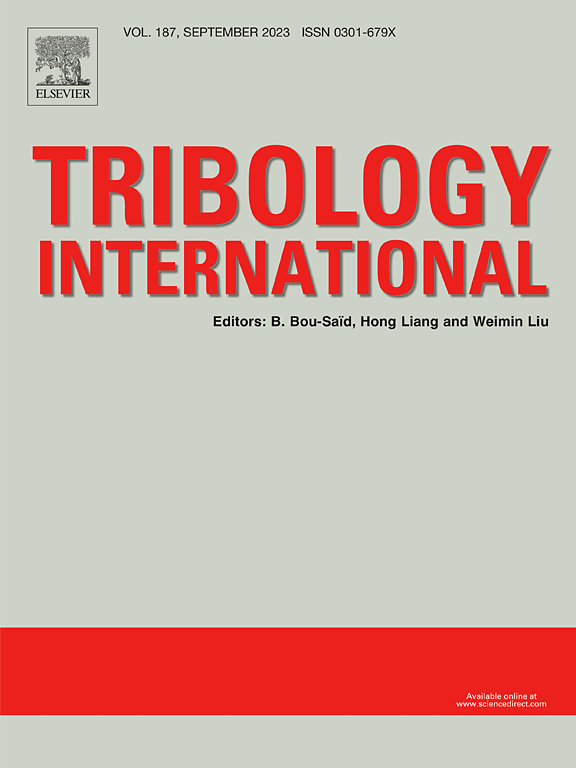Unveiling the mechano-chemical synergy of AMP derivatives as multi-functional pH regulators on C-, R-, and M-plane sapphire CMP via experiments and DFT calculations
IF 6.1
1区 工程技术
Q1 ENGINEERING, MECHANICAL
引用次数: 0
Abstract
The development of sapphire slurry follows the principles of compositional simplification, environmental sustainability, and high efficiency with low cost. This study systematically investigated the effects of polyhydroxyamine pH regulators, 2-amino-2-methyl-1-propanol (AMP), 2-amino-2-methyl-1,3-propanediol (AMPD), and tris(hydroxymethyl)aminomethane (TRIS), on the polishing performance of C-, R-, and M-plane sapphire substrates. The results demonstrated that TRIS exhibited the highest efficacy, achieving material removal rates (MRRs) of 5.512 µm/h, 3.422 µm/h, and 4.541 µm/h for C-, R-, and M-plane sapphire, respectively, while reducing surface roughness (Sq) to 0.191 nm, 0.178 nm, and 0.184 nm. Tribological analysis, SEM characterization, zeta potential measurements, particle size distribution tests, and spectroscopic techniques (UV-Vis, XPS, and FTIR) were employed to elucidate the mechanical and chemical mechanisms governing material removal. All three pH regulators can also function as complexing agents, forming complexes with , with TRIS demonstrating the strongest chelation capability. Density functional theory (DFT) calculations further verified these findings, revealing that TRIS possesses the highest number of reactive sites. The consistency between computational and experimental results established a quantitative structure-performance relationship. This work provides a green and efficient paradigm for the precision machining of hard, brittle materials.
通过实验和DFT计算揭示了AMP衍生物作为C-, R-和m -平面蓝宝石CMP上多功能pH调节剂的机械化学协同作用
蓝宝石浆料的开发遵循成分简化、环境可持续性和高效低成本的原则。本研究系统地研究了多羟胺pH调节剂2-氨基-2-甲基-1-丙醇(AMP)、2-氨基-2-甲基-1,3-丙二醇(AMPD)和三(羟甲基)氨基甲烷(tris)对C面、R面和m面蓝宝石衬底抛光性能的影响。结果表明,TRIS效果最好,对C-、R-和m -面蓝宝石的材料去除率分别为5.512 µm/h、3.422 µm/h和4.541 µm/h,表面粗糙度(Sq)分别降低到0.191 nm、0.178 nm和0.184 nm。摩擦学分析、SEM表征、zeta电位测量、粒度分布测试和光谱技术(UV-Vis、XPS和FTIR)被用来阐明控制材料去除的机械和化学机制。这三种pH调节剂也可以作为络合剂,与AlOH4−形成配合物,其中TRIS表现出最强的螯合能力。密度泛函理论(DFT)计算进一步验证了这些发现,表明TRIS具有最多的反应位点。计算结果与实验结果的一致性建立了定量的结构-性能关系。这项工作为硬脆材料的精密加工提供了一种绿色高效的范例。
本文章由计算机程序翻译,如有差异,请以英文原文为准。
求助全文
约1分钟内获得全文
求助全文
来源期刊

Tribology International
工程技术-工程:机械
CiteScore
10.10
自引率
16.10%
发文量
627
审稿时长
35 days
期刊介绍:
Tribology is the science of rubbing surfaces and contributes to every facet of our everyday life, from live cell friction to engine lubrication and seismology. As such tribology is truly multidisciplinary and this extraordinary breadth of scientific interest is reflected in the scope of Tribology International.
Tribology International seeks to publish original research papers of the highest scientific quality to provide an archival resource for scientists from all backgrounds. Written contributions are invited reporting experimental and modelling studies both in established areas of tribology and emerging fields. Scientific topics include the physics or chemistry of tribo-surfaces, bio-tribology, surface engineering and materials, contact mechanics, nano-tribology, lubricants and hydrodynamic lubrication.
 求助内容:
求助内容: 应助结果提醒方式:
应助结果提醒方式:


